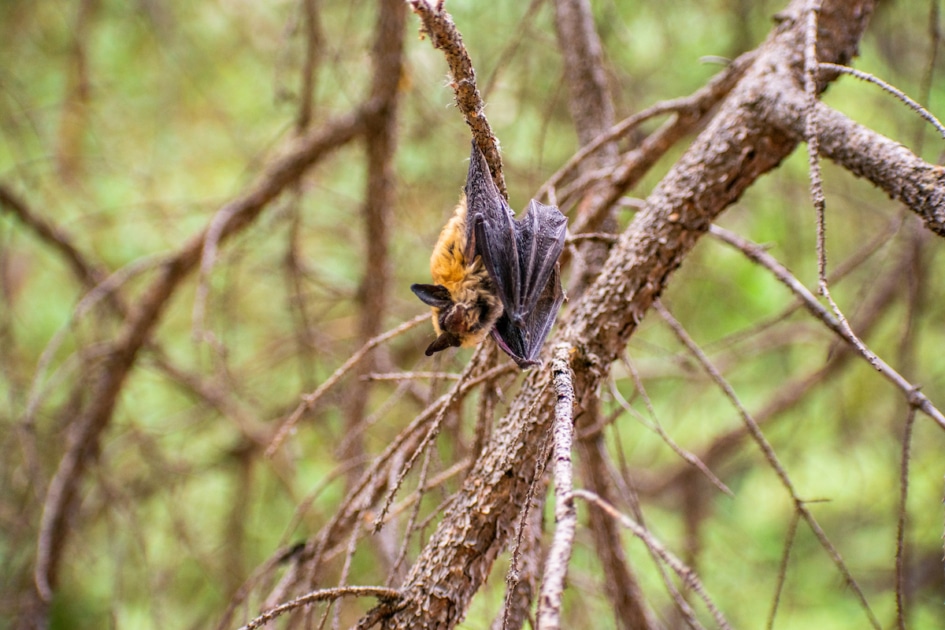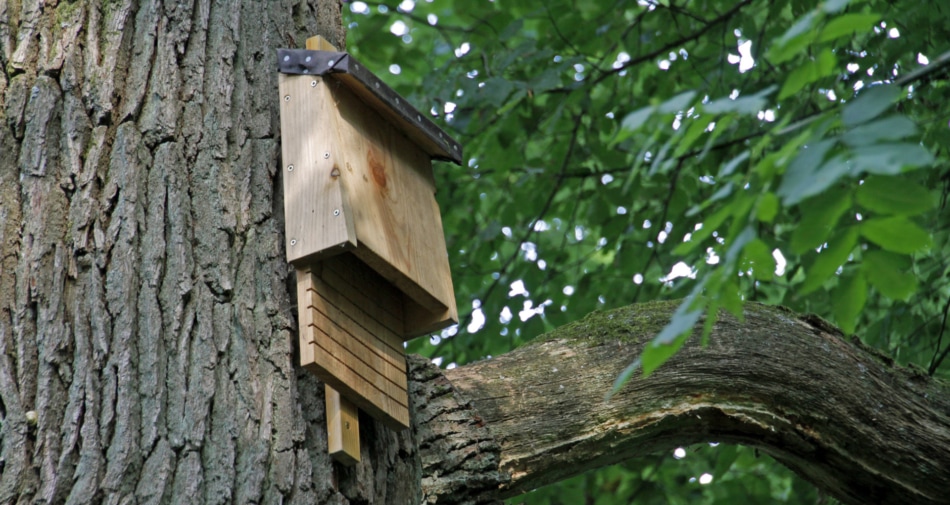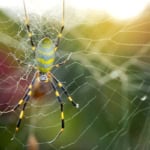Attract Beneficial Bats To Your Garden
Experts say many of us can expect a bad year for mosquitoes. Why not invite beneficial bats to your backyard for chemical-free pest control? Learn how to attract them to your backyard (and why you should)!

Experts say that with all the wet weather in many parts of the country this year, most of us can expect a bad year for mosquitoes. But rather than have them ruin your outdoor activities this summer, why not invite beneficial bats to your backyard for chemical-free pest control?
More often than not, bats get a bad rap. People think of these little creatures as blood-sucking, flying rodents, and it’s quite undeserved. In fact, these night-flying mammals are gentle, do their best to avoid human contact, and actually have a lower incidence of rabies infection than other wild animals. So why would you want them lingering around your home and garden? Bats are actually great garden companions because they are wonderful at controlling unwanted pests.
Bats: Natural Pest Controller
The little brown bat, Myotis lucifugus, is the most common species of bat in North America. These bats are insectivores, meaning their diet consists primarily of insects, and luckily for us, they have a voracious appetite. Bats can greatly reduce the population of mosquitoes and other bothersome insects that ruin your backyard activities, such as moths, wasps, beetles, gnats, midges, and mayflies. A single bat can consume more than 1,200 mosquito-sized insects per hour, usually eating 6,000 to 8,000 bugs each night!
How To Attract Beneficial Bats
To take advantage of the bat’s contribution to nature there are many ways to lure bats. Bats, like all animals, need food, water, and shelter. Since your yard and garden will provide them with their favorite meal—insects—all you will need to provide is water and shelter.
Bats generally seek shelter in secluded cracks and crevices, like in hollow trees, under loose bark, in caves, or in cracks of rocky ledges. In more populated areas they can bunk in attics, behind shutters, and in storm sewers. Bats are not inclined to chew holes in your home’s attic. However, if there are holes, they can gain access. Basically, bats like dark, tight, warm spots.
Fun Fact: Baby bats are called “pups”

Bat Habitats
Bat houses can be purchased at many home and garden centers or can be easily built in an afternoon. There are many how-to web sites, as well as free downloadable bat house plans available on the internet.
Bats also need a clean and accessible water source. They usually swoop down over open bodies of water to take a drink, such as lakes, ponds or streams. Consider building a garden pond with small plants on opposite sides. If you are short on space, a raised birdbath in an open space may suffice.
Bats feed on insects that are active at night, so in order to attract those insects, it may be beneficial to include plants that bloom at night or that have a pronounced nighttime fragrance, such as Evening Primrose, moonflower, datura, four-o’clock primrose, night-blooming water lily, night-blooming Jessamine, cleome, and nicotiana.
Bottom Line: Don’t let the myths of these nocturnal mammals turn you off. These misunderstood creatures can be of great use to control pest populations in your garden. Respect the bat’s ecological importance and consider making a place for them in your backyard.
Learn more facts about bats here!

Natalie LaVolpe
Natalie LaVolpe is a freelance writer and former special education teacher. She is dedicated to healthy living through body and mind. She currently resides on Long Island, New York, with her husband, children, and dog.






It’s funny you say “don’t let the myths turn you off” but you’re also spreading myths. The “1000s of mosquitos per night” propaganda was debunked a long time ago, and common sense should tell you that a single bat couldn’t consume 8000 insects in a day. They don’t always eat mosquitos, some don’t eat any. They can spread disease and the guano can be dangerous. The truth is in the middle.
reading carefully, the article states, 1000 mosquito SIZED insects per nite- and why should common sense dictate fact? 6-8000, not flat out 8- again, careful reading/quoting- doesn’t seem out of the scope of possibilities given the size per snack and the enormous amount of energy required to be a bat…Besides, why would this writer put her rep on the line to perpetuate falsehoods- AND why in the world would The Almanac allow it’s name to be besmirched by allowing misrepresented data to be printed under it’s banner? And yes, while guano in mass amounts, covering cave floors to crayzee depths can certainly reek havoc on the human respiratory system and be the source of extreme heat elevation in that same situation- however I highly doubt the amount of bat poop generated by the average backyard/urban dwelling bats, is going to be enough for any of us to notice, let alone suffer ill effects from- i’m pretty sure bird poop is a much larger factor in our lives actually, but i digress…at any rate, i don’t mean to start an internet comment war- and if i have offended you i apologize- i fell to temptation and just HAD to throw in my two cents… peace be with you
I bought a bat box at a local craft fair….currently researching where/how to install…..I’m also interested in planting a Bat Garden for spring, but I’m having a hard time finding info for what to plant for zone 7.
Any suggestions?
Thanks!
Have wanted to put bat houses up and attract some bats, mainly for mosquito control. Summer in Oklahoma, you know. My concern is a water source. We have a creek on one side of the neighborhood but it’s a couple miles away. I was interested in the bird bath idea. Would that keep them around? Or should we put the little pond in? One is obviously less expensive. Thanks for your help.
Last year we were lucky to have at least 3 bats around. They did an admazing job with mosquito control. The problems is all the Earth for miles around is sprayed with pest control because it’s farm feilds. Our own lawn doesn’t even grow dandelions due to a chemical treatment they use. I hope to build a few bat houses to keep and attract more but is it even safe for them here?
Is it possible to attract bats if we don’t know if they even live in our area? In Texas as far as I know, they live in Austin and other parts of the hill country. But since we don’t have hills or caves here in west central TX, I don’t think there are even any bats around. I would love to have them, though. We have too many mosquitoes right now.
What does bat droppings look like ?
What about the dangers of bat guano making you sick? Histoplasmosis?
Hi Megan, people can be at risk of histoplasmosis from pigeon droppings as well; the incidence of histoplasmosis being transmitted from bat droppings to humans is not thought to be high. Nevertheless, fresh bat droppings (unlike fresh bird dropping) can contain (but not always) the histoplasmosis fungus and it would need to be inhaled for you to be infected. Bat guano for use as fertilizer has been in practice for many years, recommended by many top gardening sources, and only requires a small amount. Should you want to make a fertilizer, and are concerned, you can wear a mask when gathering the guano.
I dont want to make anyone mad but can u tell me if u can buy bats to get them started in my neck of the woods
‘@ Marcella Ford:
Great question and it’s always good to see people wanting to help animals. It depends on the state in which you live. You can do several things.
1. Always wear good garden work gloves to proteCT yourself and the bat. Try to scoop it into a box with a lid if handy or wrap carefully in a towel.
2. If it isn’t severely injured or may have been misplaced from the nest, you can put it behind your shutters or in a crack of a tree or near some loose bark on a tree, it’ll crawl up in there and be sheltered until evening.
3. Look up or contact your local state’s ecology office, department of natural resources, wildlife or fish/game office, or any licensed wildlife rehabilitation specialists. There are several helpful pieces of information to help you get started when you type thus information into Google search…again it is going to depend on the state you live in.
4. Look up local bat or animal removal specialists in your local phone book. These people are trained to handle wildlife safely and often will find a home or a way to care for beneficial animals like bats.
Good luck and thank you again for wanting to help an injured bat.
What if you find a bat that might be injured on the ground? What can we do to help them?
Thank you for this article. I’ve always been curious about bats and now I know I wasn’t wrong to be. I love these little little critters. They are so interesting and seem so delicate up close. I knew there was more to them than the average eye sees. I am going to make moves toward making our small area more bat friendly.